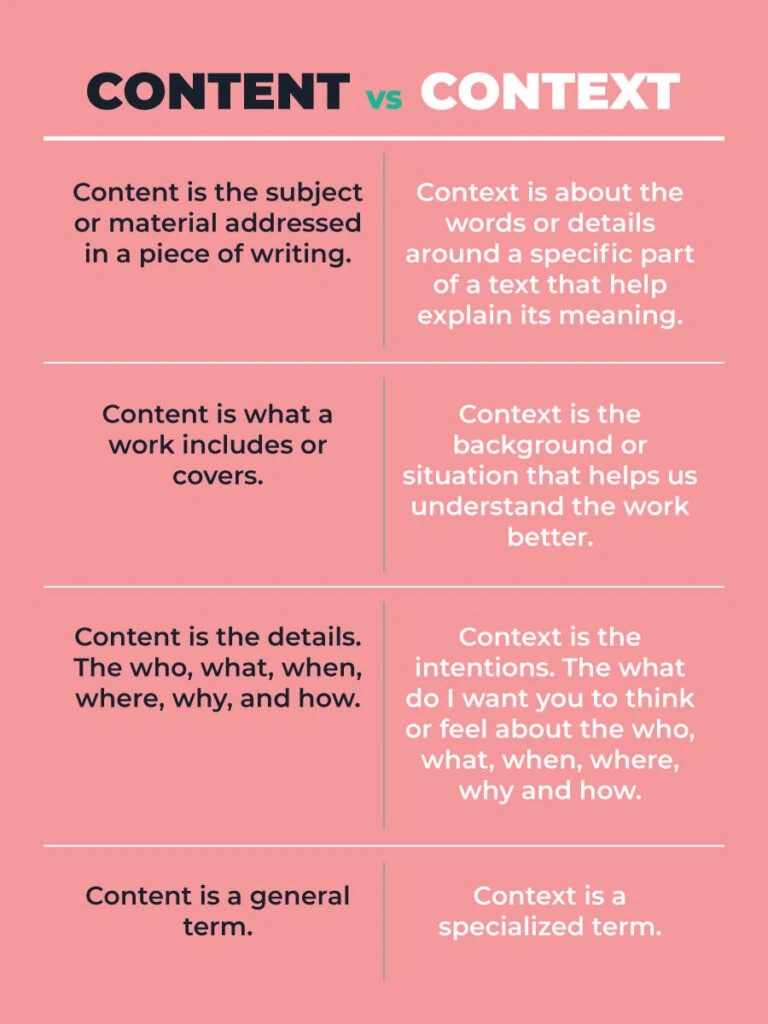Content VS Context: The Difference and importance to seo
In digital marketing, content is crucial. But without context, it’s like a king without a queen: strong but not complete.
It is not really a battle of content vs context but a balance between the two since both the content and the context are needed because they tell a story that grabs attention online.
We often hear “Content is King,” but context is just as important. They work together to boost SEO. Let’s explore how!
Key Takeaways (TLDR)
- Balanced Approach: In digital marketing, it’s crucial to pay attention to both the substance of your message and the circumstances or setting in which it’s received.
- Understanding Content and Context: Content is the actual information presented on websites, while context adds meaning and clarity to that information.
- SEO Integration: Providing high-quality content can convince search engines of your site’s worth, which improves SEO. Meanwhile, context ensures your content matches what users are looking for, resulting in a boost in search rankings.
- Optimizing for Voice Search: As voice search becomes more popular, it’s imperative to craft content that aligns with spoken queries and to comprehend the context behind these queries to succeed in SEO.
- Practical Application: To enhance both user experience and search engine rankings, adopt a content strategy that embraces diverse formats and caters to your audience, alongside a context-sensitive approach to SEO.
What is content?
Content is like the main ingredients in a recipe. It includes things like blog posts, videos, and infographics. Businesses that focus on blogging get much better results. Simply put, content is the information on websites, from articles to memes. It’s what keeps people interested and coming back to websites. Without content, websites would be empty.
HubSpot, in 2023, content marketing is now more important than ever, with nearly 80% of marketers saying their industry changed more in the past three years than in the last five decades
In Content and Search: What Do They Mean?
Context helps us understand content better. Understanding context is crucial for interpreting the information accurately. It’s like knowing you’re baking a cake for a birthday. This knowledge changes how you see the ingredients.
Contextual search tries to figure out what users really mean when they search. For example, searching for “Apple” determines whether you want information on the fruit or the tech company based on your past activities.
Consider context as the background that gives content its full meaning, like a frame around a painting that enhances its beauty.
Contextual Search goes beyond just the words you type in. It looks at the intent behind your search to give you more relevant results. So, when you search “apple,” it knows if you’re interested in the fruit or the tech company.
Contextual Search Engines: Beyond Keywords
Contextual search engines, or topical search engines, go beyond just looking for keywords. They try to understand the overall theme of your content. A good example is Google’s BERT update 2019, which aimed to grasp the context of words in searches, especially in longer or conversational phrases. These engines focus on the deeper meaning behind a search rather than just matching keywords.
What’s the difference? Content vs context?
Contextual search engines, or topical search engines, go beyond just looking for keywords. Understanding context is essential for these engines to provide relevant results. They try to understand the overall theme of your content. A good example is Google’s BERT update 2019, which aimed to grasp the context of words in searches, especially in longer or conversational phrases. These engines focus on the deeper meaning behind a search rather than just matching keywords.
Content is “what,” you say, and context is “how,” “why,” and “when,” you say it. Think of them as two sides of the same coin. Content gives us information, but the context ensures it fits the audience. If content is like a book, context is its cover and setting. For example, a love story with scary pictures wouldn’t make sense, right? The story (content) needs the right setting (context) to be clear and enjoyable.

Content Marketing and SEO: Why It Matters and Which Types Work Best?
Good content is essential for SEO because it shows search engines that your site is valuable, helping you rank higher. This includes various forms of content such as social media posts, videos, and infographics. Engaging and relevant content also attracts more links and shares. Videos are becoming especially popular. By 2022, Cisco says online videos will be 82% of all internet use. So, using a mix of videos, infographics, and longer articles can help improve SEO.
Quality content helps make your site more visible, attracts more visitors, and keeps them interested. Research by Backlinko shows long articles get 77.2% more links than short ones, boosting their SEO. Formats like how-to guides, lists, and infographics are popular and are shared more often.
Why is Context Key for SEO, and Which Methods Boost Digital Marketing Success?
Context in SEO helps figure out the reason behind a search. Understanding the specific obstacles that potential customers overcome in their journey can help create more targeted and effective content. It’s about getting why someone is searching. This helps businesses give better content. Voice searches, where people talk more naturally, also need context. Using things like structured data, rich snippets, and knowing user habits can help here.
Content that fits the search context makes it more useful for users. If search engines see your content matches what users are looking for, it can rank higher. Voice searches are getting more common. In fact, by 2022, half of all searches are expected to be voice-based.
Content and context will play pivotal roles in shaping an effective SEO strategy in the evolving voice search landscape. Content must adapt to the conversational and natural language patterns in voice queries. This entails optimizing for long-tail keywords and providing succinct, informative responses that voice assistants can easily read aloud. Crafting content that aligns with user intent and addresses specific questions will be paramount for voice search success. Additionally, featured snippets and structured content formats will be instrumental in securing a prominent place in voice search results.
Contextual understanding is equally essential. Voice search often reveals more explicit user intent, necessitating a deep understanding of why users phrase their queries in specific ways. Leveraging user behavior and search history data will enable more personalized responses, enhancing the user experience. Implementing structured data markup, harnessing Natural Language Processing (NLP), and ensuring mobile optimization are crucial steps to facilitate context comprehension by voice assistants.
Moreover, human-centric design and site speed will remain vital for voice search SEO. Overall, the synergy of content that caters to conversational queries and context that deciphers user intent will be the linchpin of a successful SEO strategy for voice search in the future, ensuring that websites remain visible and relevant in this rapidly evolving search landscape.
Using Content in Your SEO Strategy
Content is crucial online. Good content makes your brand noticeable. To create effective content, it’s important to brainstorm ideas that address customer pain points and obstacles. According to Social Media Today77% of internet users read blogs regularly, showing the power of great content. Here’s how to use content for SEO:
- Know Your Audience: Before writing, think about your readers. What do they want or need? Use surveys, feedback, and tools like Google Analytics to find out.
- Use Different Content Types: Not everyone likes reading. Some enjoy videos, infographics, or podcasts. Mixing it up helps reach more people. According to a study conducted by Jeff Bullas, articles with pictures get 94% more views.
- Choose Quality over Quantity: Instead of many short posts, a few detailed ones can make a bigger difference. According to Orbit Media, posts taking over six hours to write get 56% more leads.
- Pick the Right Keywords, but Use Sparingly: Keywords are vital for SEO. Tools like SEMrush help find good ones. But don’t cram them into your writing; it can turn readers away and risk issues with Google.
- Research long-tail keywords: Focus on keywords matching specific user searches better and ensure they align with your expertise and experience.
- Refresh Old Content: SEO needs updates. As things change, redo old content. Updated blog posts can get twice the traffic.
- Interact with Readers: Comments, shares, and time on a page matter for SEO. Respond to comments and consider using reader content to boost these interactions.
- Make It Mobile-Friendly: Over 50% of web use is on mobile, according to Statista. Ensure your content works well on phones.
In the world of online content, some companies stand out:
- Buzzfeed’s Tasty uses videos to show easy recipes, making them fun and simple for viewers. People can watch and learn how to make an “easy chocolate cake.”
- Buffer is open about wins and mistakes, making people trust them more.
- Airbnb gives guides about different neighborhoods. This is helpful to users and also boosts their ranking in local searches.
Using Context Marketing in SEO: A Simple Guide
SEO isn’t just about adding keywords anymore. It’s about understanding the whole picture. Here’s a simpler way to include context in your SEO:
- Know What Users Want: For example, if someone searches “apple,” do they mean the fruit or the company? Tools like AnswerThePublic can help figure this out. Make content that answers users’ real questions.
- Think Topics, Not Just Keywords: Search engines now look at the overall topic, not just exact words. So, if you talk about “vegan diets,” also discuss “vegan benefits,” “recipes,” and “challenges.”
- Voice Search Matters: Devices like Amazon Echo and Google Home are popular, so people use voice searches like normal conversations. Instead of “best coffee shops,” try “coffee shops near me with Wi-Fi.”
- Help Search Engines with Data: Use special codes, like schema markups, so search engines know what your content is really about. If you have a recipe blog, let search engines know it’s about cooking.
- Link Topics Together: Make a main article on a big topic, then link to smaller, related articles. This helps show you’re an expert on that topic.
- Link Wisely: If someone’s reading about “planting roses,” link to “caring for roses” instead of something off-topic like “tropical plants.”
- Keep Checking and Improving: SEO changes. Check how people use your site. Are they leaving fast? Are they asking questions you haven’t answered? Adjust based on this info.
Great Context Strategies Examples:
- Zillow doesn’t just show house listings. They give info on neighborhoods, schools, and house values. This full view helps users understand better.
- Airbnb gives search results based on what you do on their site, where you are, and what you like. They show not just any place to stay but ones that make sense for you.
- Moz has a ‘Beginner’s Guide to SEO’ that helps people new to SEO understand it easily.
- Zomato organizes restaurant reviews by looking at things like the mood of the place, how good the service is, how much it costs, and how the food tastes.
Weaving Context And Content Together
Good SEO is like setting up a stage for a play. Understanding context is essential to ensure that the content fits the audience and the situation. You need more than just good content (actors). The background and feeling (context) need to be right. In the online world, this means more clicks, better website rank, and happy visitors.
- Know Your Audience: Learn about their likes, dislikes, and habits. Use tools like Google Analytics to help.
- Address Their Problems: Talk about your audience’s challenges to make your content more relevant.
- Provide Extra Content: Give things like ‘how-to’ guides or FAQs to support the user’s journey.
- Personalize Their Experience: Use tools to suggest content or adjust website layouts based on how they act online.
The Importance of Timing in Content Marketing
Timing is everything in content marketing. Delivering the right content at the right time can significantly impact your digital marketing success. This is where context marketing comes into play. Context marketing emphasizes the importance of timing, aiming to deliver the right marketing message to the right person at precisely the right moment.
Imagine you’re a fitness brand launching a new line of workout gear. If you release your content just as people are setting their New Year’s resolutions, you’re more likely to capture their interest. By understanding the context of your audience—like their seasonal behaviors or life events—you can create content that resonates deeply and addresses their specific needs and concerns. This strategic timing can make your marketing efforts more effective and engaging, ultimately driving better results.
Context Marketing: A New Approach
Context marketing is revolutionizing the way we think about content marketing. Instead of a one-size-fits-all approach, context marketing focuses on delivering personalized and relevant content to potential customers. By analyzing the context of your audience, you can create supportive content that addresses their pain points and helps them overcome obstacles in their customer journey.
For instance, if you’re a software company, understanding that your potential customers are struggling with data management can help you create content that offers solutions to these specific issues. Context marketing adds a new dimension to content marketing, making it more effective and engaging by ensuring that the content is not only relevant but also timely and personalized.
Wrapping Up
Understanding the balance between both the content and context is like putting together a dance. Every step needs to match the beat of the music. In this comparison, the music is SEO. Simply making content isn’t enough for great SEO. It’s about mixing the content with the right context to better connect with your audience.
Think about it: if Leonardo da Vinci had only painted the Mona Lisa without her unique smile or background, it wouldn’t be as special. It’s the details, or context, that make a painting great. In the same way, adding context to your content makes it more impactful for your audience.
With so much online content today, standing out is tough. But those who combine information with purpose and context are the ones who succeed in SEO.
Digital expert Brian Solis once said, “Content is king, but engagement is queen, and the lady rules the house!” So, when making new content or updating your SEO, don’t forget the importance of context. By doing so, you can make your brand shine online. Good luck!
Measuring Content Marketing Success
Measuring the success of your content marketing efforts is crucial for understanding what works and what doesn’t. By tracking metrics such as engagement rates, conversion rates, and lead generation, you can evaluate the effectiveness of your content strategy.
To measure content marketing success, start by creating detailed buyer personas. Understand their pain points and develop a content strategy that addresses their needs. This approach ensures that you create content that resonates with your audience and drives digital marketing success.
Here are some additional tips for measuring content marketing success:
- Use Social Media Analytics Tools: Track engagement rates and conversion rates to see how your content is performing.
- Create Product Sheets and Case Studies: Demonstrate the value of your products or services through detailed documentation.
- A/B Testing: Experiment with different content formats and messaging to see what resonates best with your audience.
- Track Lead Generation and Conversion Rates: Evaluate the effectiveness of your content strategy by monitoring these key metrics.
- Customer Feedback and Surveys: Use these tools to understand what works and what doesn’t, directly from your audience.
By following these tips, you can measure the success of your content marketing efforts and create a more effective content strategy that drives digital marketing success.
Frequently Asked Questions
What is an example of content and context?
An example of content and context is a joke about a specific TV show (content) told among friends who have all seen and enjoyed the show (context). The joke’s humor might be lost on someone unfamiliar with the show, showcasing the interplay between content and context.
Why context is more important than content?
Context is often deemed more important than content because it shapes the interpretation of the content, ensuring the message is understood as intended. Without proper context, content can be misconstrued, leading to misunderstandings or miscommunications, highlighting the critical role context plays in effective communication.
What is an example of a context?
An example of a context is a group discussion on climate change among environmental scientists. Their shared knowledge and experience create a context that allows for a high level of discussion, with the assumption that basic concepts are already understood by all participants.
What is the difference between contextual and context?
The term “contextual” refers to something being related to or dependent on the context, describing how something fits into or is influenced by surrounding elements. On the other hand, “context” refers to the setting or circumstances in which a particular event or communication occurs, providing background information that helps in interpreting the content.







